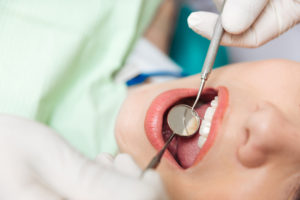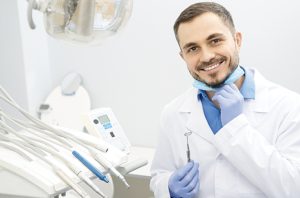Are you at risk for oral cancer? There are more than 54,000 new cases of oral cancer every year in the United States. According to the American Cancer Society, the risk of oral cavity cancer is about one in 60 men (1.7%) and one in 140 women (0.71%). Certain factors can increase the risk for some individuals.
What is oral cancer?
Oral cancer is a broad term for cancers of the tongue, lips, cheeks, the floor of the mouth, throat, sinuses, and hard and soft palate. As is the case with many types of cancers, mouth cancer can be fatal if not diagnosed and treated early on.
Oral cancer starts in the mouth, as cancerous cells grow and start to destroy nearby tissue. In some cases, oral cancer can spread to other parts of the body, such as to the lymph nodes in the neck. Oral cancer is also known as mouth cancer and oral cavity cancer.
What are the signs of mouth cancer?
Oral cancer often displays symptoms early, increasing the chances that patients can receive their diagnosis before symptoms become severe. The most common sign of mouth cancer is a sore or ulcer in the mouth or lips. Unlike other types of sores, these sores don’t heal despite the use of topical creams or treatment. The other common symptom is a pain in the mouth that won’t go away.
Other common signs of mouth cancer are:
- Unexplained tenderness, soreness, pain, or loss of feeling in the mouth, neck, or face
- Physical changes to the lips, gums, or inside of the mouth such as lumps, cracks, or swelling
- A white, red, or red-and-white patch inside your mouth
- Unexplained bleeding in the mouth
- Sores on the lips, face, or mouth that bleed often and don’t heal within two weeks
- Feeling like something is stuck at the back of your throat
- New difficulties with eating, swallowing, or speaking
- Thickening of the inner cheek
- Changes in voice or a constant sore throat
- Swollen lymph nodes in the neck
- Swelling of the jaw
- Ear pain
- A sudden change in how your dentures or retainer fits
- Dramatic weight loss
Where does mouth cancer usually start?
Oral cancer typically starts in the squamous cells of the mouth. Squamous cells are flat, thin cells that line the lips and inside of the mouth. Most oral cancers are classified as squamous cell carcinomas.
Can oral cancer kill you?
As is the case with all cancers, the earlier a patient can receive diagnosis and treatment, the better the prognosis. The overall five-year survival rate for patients with an early diagnosis of oral cancer is 84%. However, if the oral cancer has spread to other parts of the body, the five-year survival rate is 65%.
Oral cancer can — and does — kill patients. It’s estimated that 9,750 people die every year in the United States from oral cancer. This translates roughly to one person per hour.
Some of the other factors that can contribute to a person’s chances of recovery include:
- Stage: The stage the cancer is at when it’s diagnosed.
- Tumor thickness: The thinner the tumor, the better the prognosis. Thicker tumors are more likely to spread to the lymph nodes in the neck and return in the same place (local recurrence).
- Margin status: The area of healthy tissue around a cancerous tumor that is removed during surgery is known as the margin area. The doctors test this area for the presence of cancerous cells. If the test shows cancer cells in this area, it’s known as a positive surgical margin. Conversely, a clean test is known as a negative margin. Individuals with a negative surgical margin have a better chance of recovery.
- Spread to the nerves: Mouth cancer that has grown into or along the nerves tends to have a poorer prognosis.
- Spread to the lymph nodes: Individuals who have oral cancer that has spread to the lymph nodes in the neck have poorer chances of recovery.
- Location: The location of the oral cancer can reduce or improve the chance of recovery.
Who is at risk of mouth cancer?
Mouth cancer can happen to anyone, but certain factors increase a person’s risk. Those factors include:
Smoking
Cigarette smokers are approximately ten times more likely to get oral cancer compared to non-smokers. Cigars pose a similar risk. Regular cigar smokers are between 4-10 times more likely to die from oral cancer than their non-smoking counterparts.
The same increased risk applies to chewing tobacco and pipe tobacco.
Alcohol
There is a direct link between moderate and heavy consumption of alcohol and an increased risk of oral cancers:
Moderate drinkers are 1.8 times more at risk for oral cancer (excluding the lips)
Heavy drinkers are fives times more at risk for oral cancer
Genetics
A family history of a specific type of cancer makes it more likely to impact others in the family line.
Excessive sun exposure
Lip cancer is more common in individuals who have been exposed to excessive sunlight or UV rays. For example, occupations that require outside work in the sun — like farmers — have higher rates of lip cancer. Lip cancer often occurs on the bottom lip as this is the area that receives the most direct light exposure.
HPV
HPV is a broad term referring to more than 100 types of related viruses. Many strands of HPV can be spread through sexual contact, such as oral sex. HPV-16 and HPV-18 may increase the risk of oral cancer.
How is mouth cancer treated?
Oral cancer is treated by:
- Surgery to remove the cancerous tumor and testing of the margin status (nearby healthy tissue) for cancer cells
- Radiation therapy or chemotherapy to destroy remaining cancer cells
- Frequent check-ups to ensure the cancer doesn’t return
How to reduce the risk of oral cancer
Every person can take steps to reduce the risk of oral cancer while also being proactive in watching out for early warning signs. These steps include:
- Quitting all forms of tobacco (smoking, vaping, cigars, chewing tobacco, pipes, etc.)
- Drinking only in moderation
- Eat a well-balanced diet full of vitamins and minerals
- Staying out of the sun, wearing sunscreen, and wearing hats
- See your dentist regularly. Most likely, a dentist can spot early signs of oral cancer before you do. During your regular check-up, your dentist will examine you for irregular tissue changes, lumps, sores, and other signs of mouth cancer. This is why it’s so important to see your dentist, at a minimum, for your bi-annual cleanings.
- Book an appointment with your doctor the minute you suspect something is wrong. Early diagnosis is essential for a full and quick recovery.
If you’re concerned about oral cancer, consider visiting a dentist to address some of your worries.
Need to find a dentist near you? Visit our directory to find a certified pain-free dentist in your area!
















